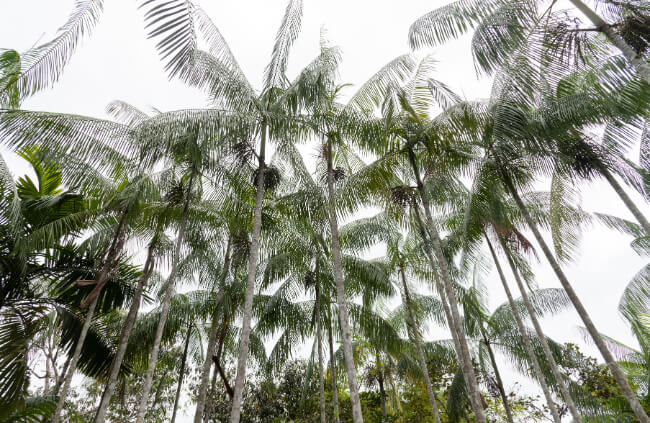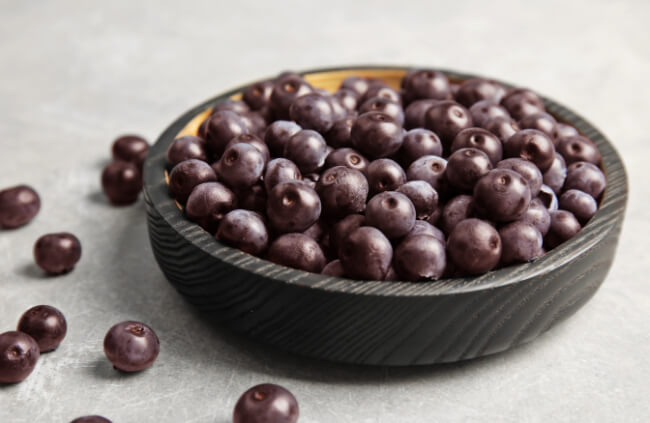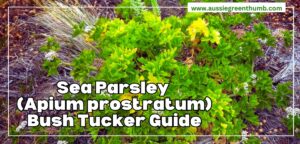It always astounds me the number of plants, fruits and vegetables that are so rich in some vitamin or mineral and how they then become the “wheatgrass” of tomorrow. Let me introduce you to Acai palm (pronounced Ah-Sigh-Ee).
More...
Introducing the Acai Palm
The Acai palm is native to the tropical regions of Central and South America. They grow to about 15-30m (50-100ft) tall in groves along the banks of floodplains and swampy areas.
They’re prized for two things:
- The palm heart which is as it sounds the heart of the palm,
- The grape-like berries which can be harvested, pulped, and juiced.

Acai Palm Heart
Harvesting the palm heart destroys the palm however, they are prone to suckering and the suckers can be harvested without affecting the parent plant. The palm heart is a delicacy and the price limits those who can afford to enjoy it.
Acai Berries
The berries, on the other hand, are a renewable resource. They grow in bunches of more than 700+ berries per branch and each berry is similar in shape and size to a grape except that it contains only one central seed. The reason they are so highly prized is for their richness in Vitamin B and anthocyanin, a flavonoid antioxidant.
Unfortunately, the acai berries deteriorate quickly once they are harvested and so they will never appear in the fruit and veg shop retailing as a stand-alone fruit. They can, however, be pulped and the fruit juice extracted and bottled.
It seems that there are opportunists searching the world over looking for the next fruit elixir that will offer people something extraordinary and gain incredible sales for the pioneer. Acai fruit is no different.
These berries were first harvested by the Yanomami Indians in the Amazon rainforest prior to its discovery and have now been cast as a natural “Viagra” among its other innumerable health benefits.
Growing Acai Palm in Australia
If you live in the right climatic conditions and you could legally source some plant stock, there is no reason why you couldn’t grow your own acai. Like any palm they will need plenty of moisture, preferring to source their own through wetted mulch or sitting alongside a watercourse.
If you live in a semi-tropical region growing an acai would also be possible but it would require being placed among a constructed rainforest. That is you will need to create a garden that could rejuvenate itself and its own moisture needs.
The acai palm won’t require much in the way of fertiliser, and it would be best to use organic fertilisers than rely on chemical sources.

What are the Health Benefits of the Acai Berries?
The acai berry is touted as a preventative against heart failure, assisting as a benefit against cancer, dementia, and other age-related diseases. But it all depends on who’s telling you and what they’re selling.
The juice of the acai fruit is also being tested as a dye for use in MRI scans.
What to do with the Acai’s Fruit?
As the fruit doesn’t keep fresh for long at all, you would need to pulp and juice it almost immediately after picking. Once this has been done it can be consumed straight away as a fruit juice drink or mixed with other ingredients to produce a fruit smoothie.


Get Your Free Guide:
Master Growing Australian Natives eBook
A Must Have Complete Guide for Every Australian Garden
Get Your Free Guide:
Master Growing Australian Natives eBook
A Must Have Complete Guide for Every Australian Garden
The acai fruit juice can also be stored by freezing the pulp, or just the juice, or storing it in bottles and it would be recommended that they keep refrigerated.
Published on June 3, 2023 by Gary Clarke
Last Updated on February 8, 2024





Hi Gary,
My name is Daniela, a fellow plant enthusiast – and particularly ones which can provide us with sustenance.
Good to see that someone is giving the possibility of acai being planted in Australia some thought! I am interested in this and see it as a sustainable food source myself.
Are you able to tell me if this is already being done in Australia – either domestically or at commercial scale?
Hi Daniela,
As far as I’m aware there’s no commercial plantations in Australia, but there are definitely a few passionate allotment gardeners making use of these incredible plants.
They’re a great food though, not just for the health benefits. They genuinely just taste great.
I hope more people get on board and start growing them. There are definitely parts of the country that would be viable for commercial crops too.
Who knows what the future holds!
Best regards,
Gary Clarke